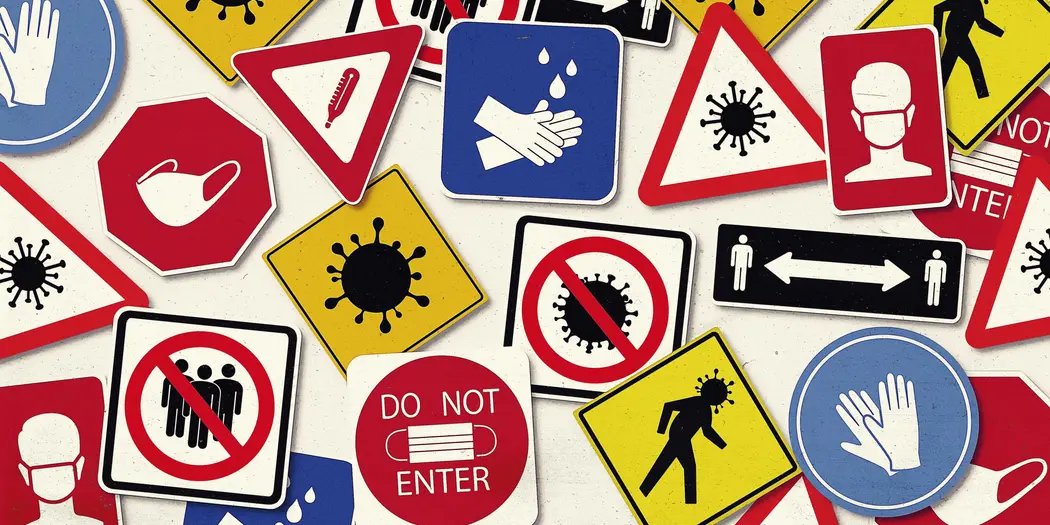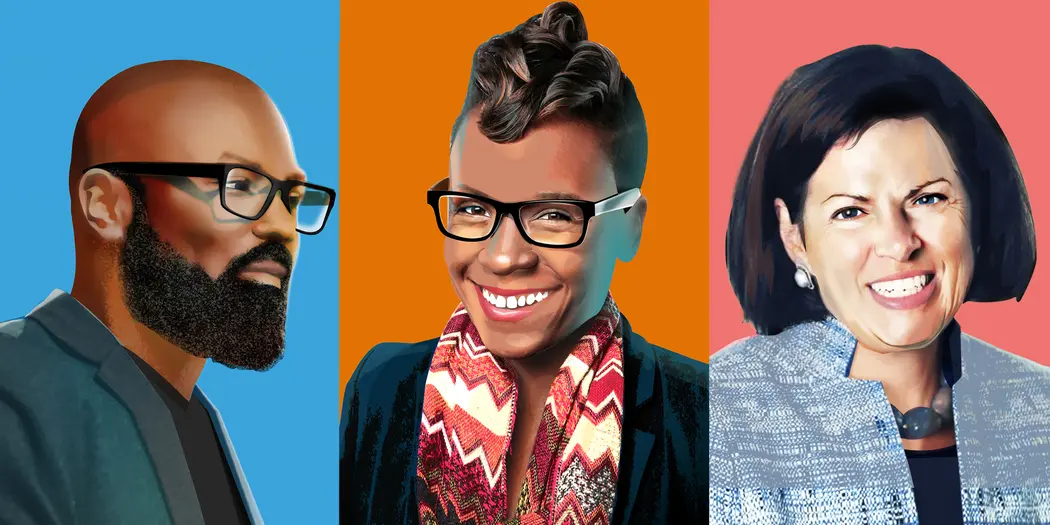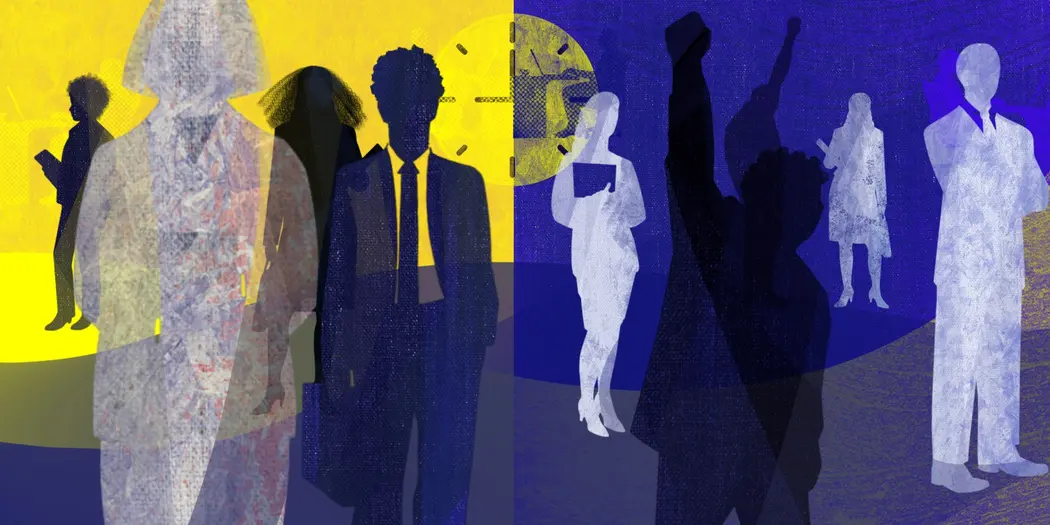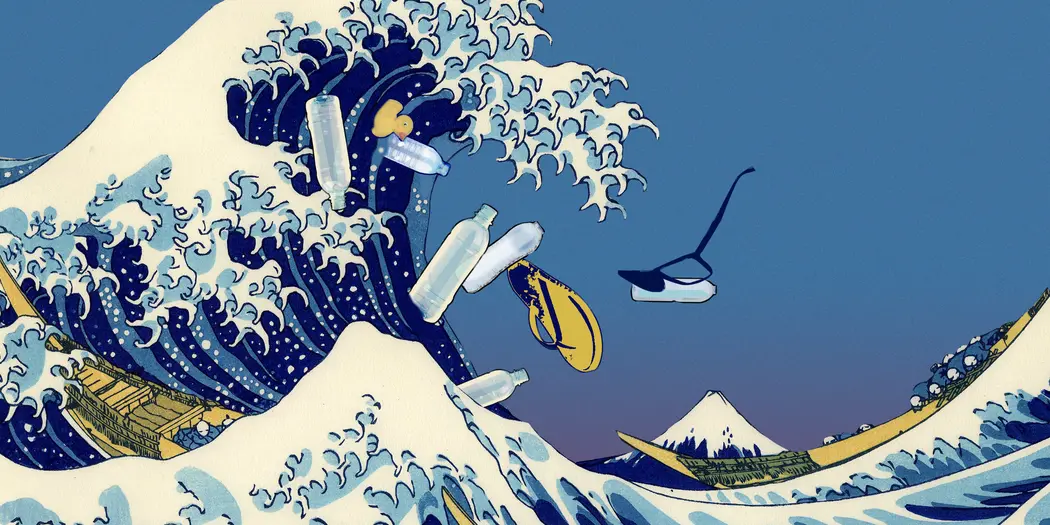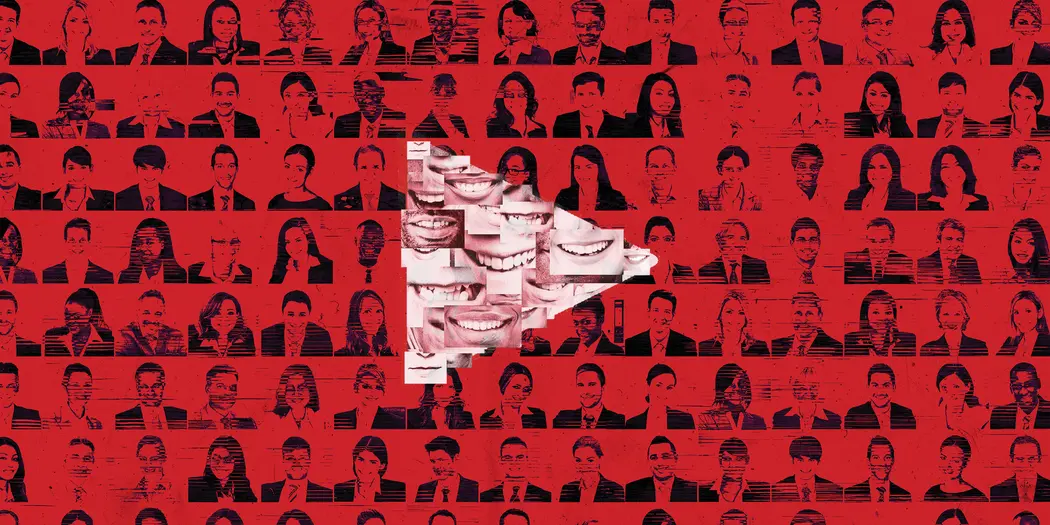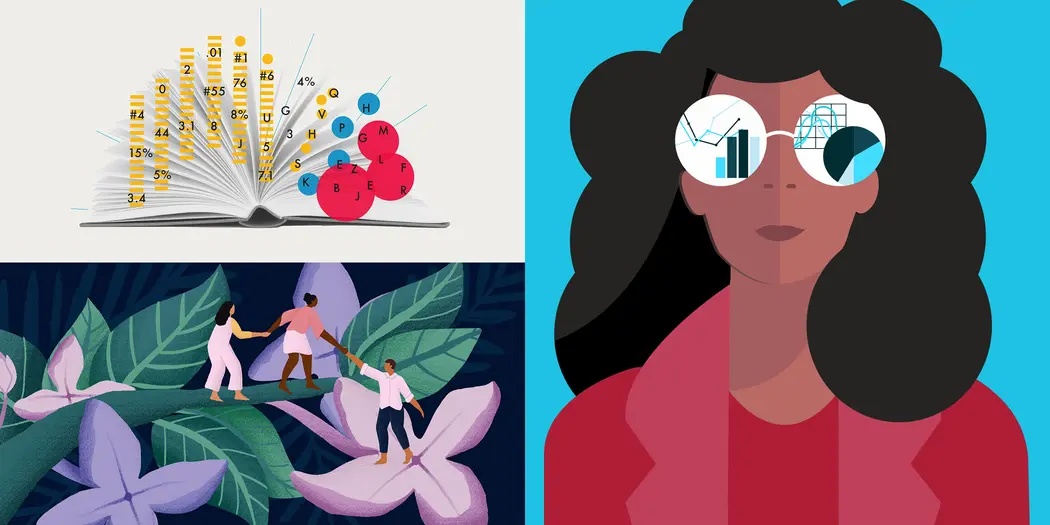Credit: Erin Robinson / Sebastien Thibault / Stephen Sauer / Rob Dobi
A great illustration is not just beautiful or eye-catching. It can illuminate an idea and elicit emotion instantly. It can elevate a story and enhance the reader’s engagement with it.
And in the tumultuous year that was 2020, illustrators were inspired. They added depth to and helped us understand complex ideas in our stories covering topics ranging from the coronavirus pandemic to racial equity. Here are six of the illustrations we loved in 2020.
Credit: Rob Dobi
The cost of uncoordinated responses to COVID-19
Since the COVID-19 pandemic began, we’ve all had to regularly confront hard questions: When and where should we wear masks? Is it safe to go to the gym? Why are restrictions so different for me, my friend across the country, and my cousin one state over? Sometimes navigating life during the pandemic feels like pulling up to an intersection that has a bunch of different traffic signs, some of them unclear or contradictory.
Rob Dobi captures this confusion with an illustration of road signs emblazoned with pandemic images that have become familiar, like the hand washing symbol and social distancing arrows. It seems like a peek inside our collective consciousness these days. During times of uncertainty, we turn to science-based guidance and messaging — and lack of clarity is costly. A study about the cost of uncoordinated coronavirus policies showed that pandemic policies are less effective overall when they vary from place to place. One reason, the researchers found, is that people are affected by the behavior of others, even those geographically distant. We’re looking in lots of different places for signs about what to do, trying to decide which ones to follow. — Sara Brown, news writer
Credit: Sébastien Thibault
In cities, the escalator of opportunity has stalled
New work from MIT economist David Autor confirms a suspicion many have harbored for decades: American cities are no longer drivers of economic mobility. The twin threats of automation and globalization have atomized the good jobs once available to less-educated and lower-income people in urban areas. While college-educated city dwellers still see wage gains relative to their peers elsewhere, those without a degree have seen wages decline by as many as 13 percentage points relative to non-urban workers with a similar education level.
Sébastien Thibault’s illustration summons the scale of this bifurcation of fortunes, as well as the scant options available to those left behind. Wedged into an isolating landscape, a person can glance up just far enough to see the opportunity afforded to others recede from view. But they have no way to follow, no means to climb out, and no clear path to a better future. — Zach Church, editorial director
Credit: Stephen Sauer
My Idea Made to Matter
This year MIT Sloan introduced a new Q&A series, My Idea Made to Matter, featuring insight from leaders and creators on how they develop and work with ideas. The interviews are both unique and collective — meaning each person profiled has their idiosyncrasies and singular life journeys, yet as innovators, they share a commitment to deep collaboration and casting the widest net possible to source ideas.
The illustrations that accompany these interviews needed to reflect that duality, with imagery that captures the essence of the individual while also tying the profiles together as part of a larger series. Against background colors that are bold and unexpected, contributing artist Stephen Sauer creates warm and welcoming digital portraits that show the power, conviction, and vitality of their subjects. Pictured here from left: Craig Robinson, co-author of the Business for Racial Equity Pledge, Blendoor founder Stephanie Lampkin, and Analysis Group CEO and chairman Martha Samuelson. — Tracy Mayor, senior editor and writer
Credit: Erin Robinson
3 ways leaders can make Black lives matter in the workplace
With centuries of structural and social prejudices as a foundation, ensuring Black lives matter in the workplace is easier said than done. And proclaiming that Black lives matter is simply not enough. It requires perspective taking, thoughtful leadership, and structural and symbolic changes within a company.
This deep commitment to achieving racial justice is embodied in Erin Robinson’s brave, complex, and evocative illustration. Although digital, the layers of texture and color feel tactile like a painter’s canvas and evoke a feeling of hardship. There’s a movement to the shapes and the people layered in the foreground and background that signify the Black lives matter movement in itself and the need for real dialogue and empathy. Lastly, the symbol of the clock, so emphatically centered, indicates that it’s more than time to confront centuries of systemic racism and address policies on anti-Black racism at work. — Mimi Phan, assistant art director
Credit: Stephen Sauer
In the global water crisis, an opportunity for private business
In a year of global pandemic, economic tumult, and mass protests for racial equity, the urgency of the environmental crisis has at times taken a back seat. But there is perhaps no better indicator of the severity of this predicament than the current state of our oceans and waterways. Some 1,500 plastic water bottles are used every second in the United States, and by 2050, there will be more plastic in the ocean by weight than fish. Much in the same way that photos of floating trash heaps and beached refuse make us cringe with guilt, Stephen Sauer’s illustration invites a moment of pause for some difficult self-reflection. The jarring image of plastic litter tumbling amidst Katsushika Hokusai’s resplendent “The Great Wave” is emblematic of our own callous disregard for nature.
Thankfully, the MIT Water Summit held in late 2019 featured a spectrum of ideas for confronting this menacing threat. Proposals included taxing plastic, rethinking beverage packaging, and even branding municipal water. The challenges facing our global water supply are many, but so are the opportunities for innovative solutions from both the public and private sectors. — Devon Maloney, social media editor
Credit: Rob Dobi
Deepfakes, explained
In our deepfakes explainer, technology experts describe the evolution of data manipulation, how to spot a deepfake, and ways in which business leaders can protect themselves and their companies against the threats that come in this form of synthetic media.
Illustrator Rob Dobi handled the art for this explainer, and our assistant art director Mimi Phan said that at first she “was really shocked by the red, but it helped provide that sense of urgency.” She’s right. There is an urgency to understanding and protecting against deepfakes. We also wanted diverse profiles and smiles in the background layer, because deepfakes can affect anyone, and the “play” icon is a familiar symbol that reminds us that just one click is all it takes to start something that might be entertaining — or much worse. — Meredith Somers, news writer
Credit: Laura Wentzel (top left, right) / MyTien Pham (bottom left)
Other illustrations that illuminated our stories:
Laura Wentzel’s Bauhaus-inspired design for The next chapter in analytics: data storytelling (pictured top left) made a complex topic pleasing and approachable.
For 3 mantras for women in data (pictured right), Laura’s minimal, yet bold style illustrated the need for more women and people of color in the booming data field. Although the woman in the illustration sees data visualizations in her glasses, it is her mouth that catches your attention. Like Mona Lisa’s famous smile or lack thereof depending on how you see it, the reader is left pondering this woman’s dead-on stare and what she’s thinking.
MyTien Pham’s surreal illustration (pictured bottom left) of three people helping each other climb up a flowering branch beautifully portrayed how to elevate an inclusive community of entrepreneurs through a supportive entrepreneurial ecosystem where those with access lift others up along the way.

